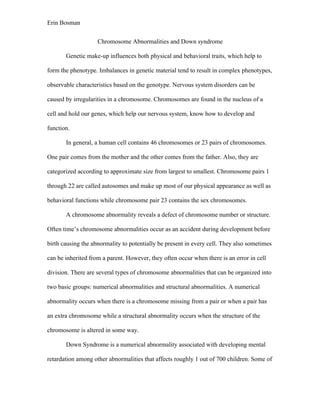
Chromosome Abnormalities and Down Syndrome Explained
- 1. Erin Bosman Chromosome Abnormalities and Down syndrome Genetic make-up influences both physical and behavioral traits, which help to form the phenotype. Imbalances in genetic material tend to result in complex phenotypes, observable characteristics based on the genotype. Nervous system disorders can be caused by irregularities in a chromosome. Chromosomes are found in the nucleus of a cell and hold our genes, which help our nervous system, know how to develop and function. In general, a human cell contains 46 chromosomes or 23 pairs of chromosomes. One pair comes from the mother and the other comes from the father. Also, they are categorized according to approximate size from largest to smallest. Chromosome pairs 1 through 22 are called autosomes and make up most of our physical appearance as well as behavioral functions while chromosome pair 23 contains the sex chromosomes. A chromosome abnormality reveals a defect of chromosome number or structure. Often time’s chromosome abnormalities occur as an accident during development before birth causing the abnormality to potentially be present in every cell. They also sometimes can be inherited from a parent. However, they often occur when there is an error in cell division. There are several types of chromosome abnormalities that can be organized into two basic groups: numerical abnormalities and structural abnormalities. A numerical abnormality occurs when there is a chromosome missing from a pair or when a pair has an extra chromosome while a structural abnormality occurs when the structure of the chromosome is altered in some way. Down Syndrome is a numerical abnormality associated with developing mental retardation among other abnormalities that affects roughly 1 out of 700 children. Some of
- 2. Erin Bosman the abnormalities associated with Down syndrome are learning disability, heart defects, and early onset Alzheimer’s disease. In general, the nucleus of a cell contains 23 pairs of chromosomes while in individuals with Down syndrome there typically is an abnormality of a trisomy of the chromosome 21. Chromosome 21 is the smallest human chromosome. Often it is the mother that passes down the extra chromosome. Supposedly, this extra chromosome results in an increased expression of some of the genes on the chromosome. Three different variations of Down syndrome exist: trisomy 21, translocation, and mosaicism. Trisomy 21, or nondisjunction, is an error in cell division where an embryo has three copies of chromosome 21. Nondisjunction is the case for ninety five percent of Down syndrome cases. Translocation occurs when part of chromosome 21 separates during cell division and attaches to another chromosome, which is often chromosome 14. The number of chromosomes in the cells remains 46 but the occurrence of an extra part of chromosome 21 causes the abnormality of Down syndrome. In addition, mosaicism occurs when nondisjunction of chromosome 21 takes place in one of the initial cell divisions. This causes there to be a mixture of two types of cells, some with the usual 46 chromosomes and others with 47 chromosomes. Those cells with 47 chromosomes have an extra copy of chromosome 21 leading to Down syndrome. Those with mosaic Down syndrome may have fewer characteristics than those with other types of Down syndrome. Down syndrome is a widely known chromosome abnormality however there are quite a few chromosome abnormalities in existence such as Turner syndrome, Wolf- Hischhorn syndrome, and Jacobsen syndrome. Turner syndrome occurs when one of the x chromosomes in females is incomplete. Symptoms of Turner syndrome can be
- 3. Erin Bosman incomplete sexual development and infertility. In addition, Wolf Hirschhorn syndrome is caused by the deletion of the short arm of chromosome 4, which results in delayed development and seizures while Jacobsen syndrome results in delayed development as well. Jacobsen syndrome is caused by a loss of genetic material from the chromosome 11. Usually, chromosome abnormalities are found through inspection of the chromosomes under a microscope. The use of molecular cytogenetic technologies has allowed for the identification of imbalances that aren’t visible with the microscope. This has allowed for the discovery of new conditions. Many chromosomal changes are large and include numerous genes. Individuals with overlapping may allow for further research. A chromosomal abnormality can affect the number of chromosomes and the composition of chromosomes. If the chromosome is balanced so that the expected amount of material is found in each cell the abnormalities do not occur. If the balance is altered then chromosomal abnormalities occur and can cause a wide range of malfunctions.
- 4. Erin Bosman Chromosome Abnormalities Fact Sheet. (n.d.). Retrieved January 24, 2015, from http://www.genome.gov/11508982 Theisen, A., & Shaffer, L. (n.d.). Disorders caused by chromosome abnormalities. Retrieved January 24, 2015, from http://www.ncbi.nlm.nih.gov/pmc/articles/PMC3681172/ Roper, R., & Reeves, R. (n.d.). Understanding The Basis For Down Syndrome Phenotypes. PLoS Genetics, E50-E50. What Is Down Syndrome? (n.d.). Retrieved January 24, 2015, from http://www.ndss.org/Down-Syndrome/What-Is-Down-Syndrome/ Wiseman, F., Alford, K., Tybulewicz, V., & Fisher, E. (n.d.). Down Syndrome--recent Progress And Future Prospects. Human Molecular Genetics, R75-R83.